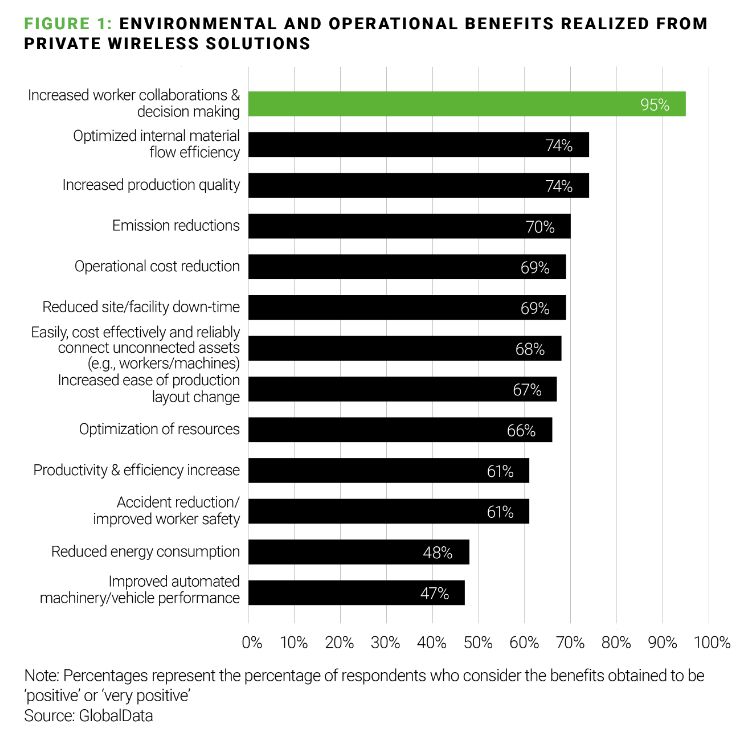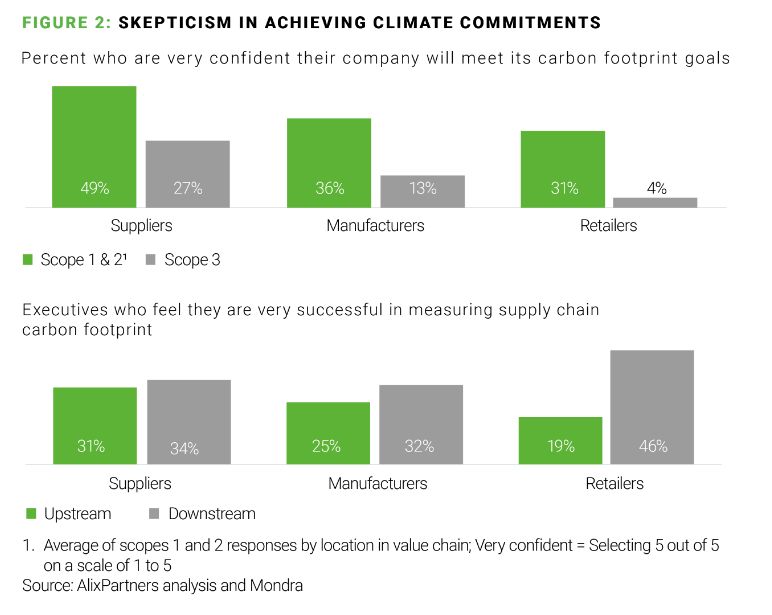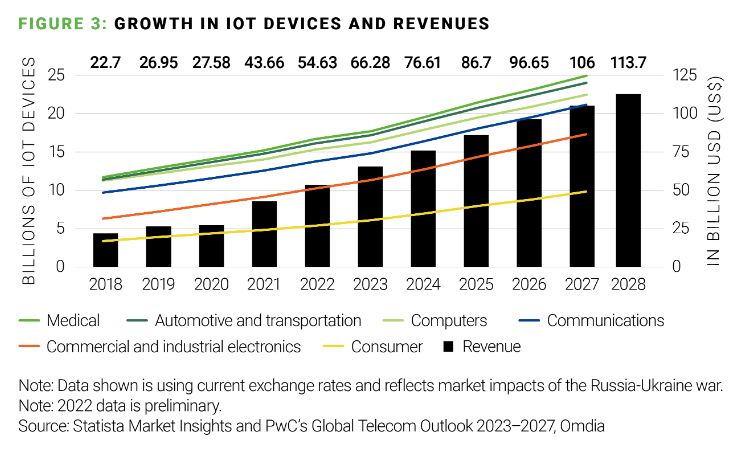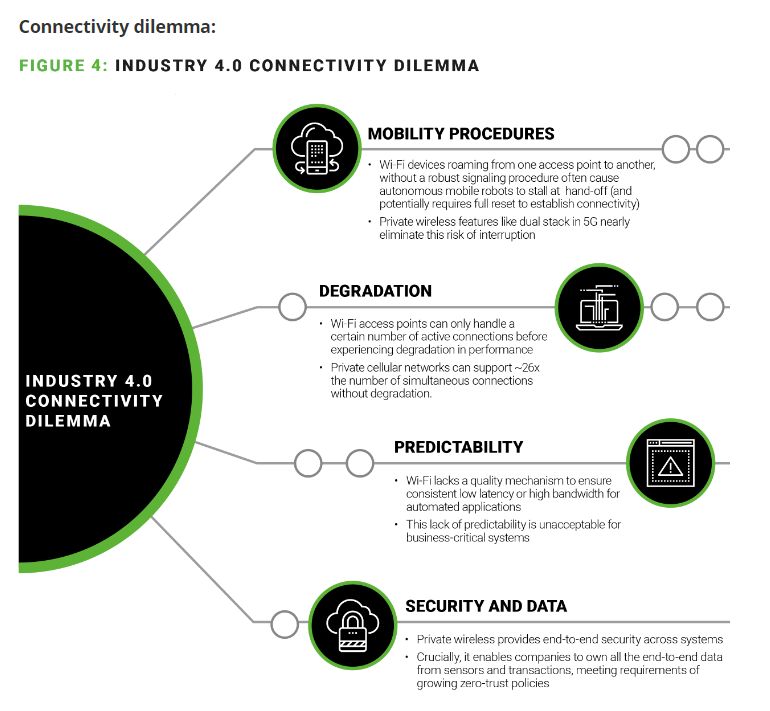The emergence of private wireless networks comes at a crucial time for telco operators. As value loss and migration proliferate, these networks offer a largely untapped revenue stream, if operators can strike back against new connectivity entrants.
Beyond revenue, private networks allow operators to redefine their role in customers' digital transformations. They are now able to offer end-to-end managed solutions that underpin key Industry 4.0 use cases, providing fiber-like speed and capacity with distributed compute and storage abilities that enable low-latency applications. This drives a level of efficiency that wired networks and older wireless technology cannot attain.
While the private wireless market is still in nascent stages, last year Global Data surveyed 79 multinational early adopters. The results illustrate the transformative environmental and operational impacts these networks can provide:

As technology continues to evolve, private wireless networks will serve as a connecting platform to build AI, extended reality, and IoT capabilities. These connected technologies not only have the power to further transform operations, but also combat climate change. Companies across all industries have responded to customer and investor calls for aggressive climate action by committing to net-zero operations and products. According to Climate Impact Partners, in 2023 66% of Fortune 500 companies made such climate commitments. However, recent surveys conducted by AlixPartners, Mondra, and the BRC Climate Action Roadmap Pathway show that many of these companies are not confident they will reach their ambitious targets:

Increasingly stringent carbon taxes, government regulations, and reporting requirements present significant reputational and financial risks for companies that fail to comply—and private wireless networks can help. Network modernization efforts that leverage the latest fiber and cloud technology allow companies to be much more energy efficient. They can also more effectively monitor solutions for energy consumption in real time via 5G's ultra-low latency and IoT.
We are now entering the last mile of digitization, where telco operational use cases must translate into sustainable benefits. To turn these environmental targets into reality, companies must also commit to operational transformation and solutions. The first step in this transformation is choosing the right connectivity infrastructure.
Companies must align operational visions with connectivity capabilities:
The use of connected applications to boost environmental and operational effectiveness is growing exponentially. Ericsson predicts the number of IoT connections will expand from 12.4 billion in 2020 to 26.4 billion in 2026. The industrial sector alone has nearly doubled its connections since 2020 and is quickly adopting IoT tracking and production systems to reduce energy consumption, manage inventory, implement preventative maintenance, and digitalize manufacturing procedures.

Connected facilities boost production and energy efficiency, serving as a catalyst for carbon footprint reduction. For example, manufacturers are leveraging sensors and analytics platforms to monitor environmental plant conditions like temperature and humidity. This helps prevent costly waste, as high-value components such as chipsets can be monitored to avoid humidity damage and machine temperatures can be monitored to utilize coolant solutions more effectively. Furthermore, the corresponding data captured from these connected networks enables manufacturers to reliably label products as "zero-carbon."
The proliferation of these connections and use cases presents a new traffic challenge for companies attempting to operationalize Industry 4.0 concepts. Successful deployment of IoT, drones, predictive maintenance, and AR/VR applications requires lower latency and higher bandwidth and speeds than legacy networks can provide. For instance, a leading car manufacturer placed Wi-Fi access points every 20 meters in its factory, and still couldn't realize any incremental improvements to automating floor operations. This manufacturer ultimately implemented private 5G to triple the number of automatic-guided vehicles it was using in production. For large operations, private 5G networks have the unique ability to support real-time communications, device density, and machine-to-machine interactivity with ultra-reliable, low latency.

Telco operators are uniquely positioned to facilitate private wireless enabled digital transformations—particularly when delivering these as end-to-end managed solutions:
Companies seeking to evolve operations through the intersection of edge-computing technologies and private wireless networks must navigate an extremely complex value chain of operators and vendors. We believe operators have the right to win in this emerging market.
Their private networks are unique from competitors as they can be augmented with existing and impending infrastructure. This combination allows them to deliver unlimited connectivity by seamlessly transitioning between small-loop private networks, public networks, and newer satellite options. The inherent scale of operators gives them a price advantage, as their robust networks of integration partners reduces the strain and cost of building up field capabilities.
To realize the full potential of these advantages, operators should expand their focus beyond large-scale customers. Companies larger than $5 billion can build their own private networks, while smaller companies will benefit most from operators' end-to-end scale and structure. To address smaller companies' needs, operators must first understand the barriers to entry these companies typically face:
1. Network design
Broad vendor bases and continued innovation, require a central systems integrator with access to a combination of top products, capabilities, and services.
Telco operators can serve this role, as their knowledge of how networks are constructed can provide pivotal oversight for radio frequency design and IT component placement, while proven open architectures allow the flexibility to bypass supply chain issues.
2. Spectrum flexibility
Companies may need to deploy on multiple spectrum types and bands for certain use cases, such as user equipment that requires licensed mid-band spectrum.
Operators can function as a one-stop-shop supporting both licensed and unlicensed deployments, rather than being relegated to "the carrier providing spectrum."
3. RAN Intelligent Controller (RIC)
A RIC is a central component of an Open Radio Access Network (RAN) that oversees and enhances RAN operations. It's critical to providing visibility to key performance data, such as the use of xApps, AI, and machine learning to optimize RAN operations, as well as the prioritization of RAN resources.
Operators can partner with OEMs (original equipment manufacturers) or offer their own suites of xApps to aid here. They can create standard protocols (APIs) that mitigate workaround efforts to use applications on RANs.
4. Backhaul strategy
Companies must identify backhaul options to supplement their private networks. In some cases, they may need to modify existing infrastructure to reduce potential congestion, such as LAN (local area network) distribution frames.
Telcos have the expertise to evaluate bottlenecks in legacy infrastructure and manage upgrades to reduce congestion.
5. Security
Companies may need to reassess security management programs to accommodate wireless vs. wired networks; this provides the opportunity to deploy more robust, zero-trust security architectures. At the same time, they must balance heightened security efforts with performance objectives, which often requires a hybrid, onsite multi-access edge computing (MEC) and cloud approach.
Operators can embed these security options into their offerings through internal development or strategic partnerships. But they will have to compete with other key players in the market to succeed here. Nokia, for example, offers its top-of-the-line, proprietary Net Guard Cybersecurity Dome for network security assurance.
6. Network operations
Private networks require ongoing resources to run effectively; John Deere recently increased staff to manage its network by 20%. but the technical knowledge needed is generally outside the realm of traditional, in-house IT teams.
As such, most enterprises outsource network management. Telco operators are positioned to dominate this market due to their experience with FCC mandates that come with licensed spectrum (i.e., 911 compatibility, uptime, and more). Operators can deploy field teams to provide dedicated onsite resources, which is crucial for installation and onboarding as well as updating devices and applications. Private network performance depends on the operational rigor companies can implement, and telcos are uniquely able to provide these real-time monitoring and maintenance capabilities.
7. Equipment compatibility and services
5G-native equipment is increasingly available, but certain use cases or legacy equipment may still require retrofitting to enable 5G compatibility.
Telco operators can facilitate workarounds when existing equipment doesn't work with a private network, and can leverage relationships with vendors to identify alternatives when workarounds are not feasible. Furthermore, operators' large in-field workforce scan assist customers through implementation and upgrades.
Growth in edge computing and devices also presents an opportunity for operators to include certain maintenance, repair, and operations services within their end-to-end offerings. This upsell can be worthwhile for companies, as smart manufacturing equipment requires technical knowledge their in-house service departments often lack.
Private wireless and edge computing are critical enablers of the ongoing Industry 4.0 transformation, aiding organizational pushes to achieve lofty environmental and operational goals. However, the role telco operators will play in this transformation remains uncertain.
The current market is dominated by OEMs like Nokia that offer private-network-as-a-service models; Nokia and Kyndryl, the world's largest IT infrastructure services provider, just announced a three-year extension and expansion of their global network and edge partnership. But in our view, it is telco operators that are best equipped to provide companies with these services at scale.
Operators should be the trusted partner for end-to-end private wireless solutions, facilitating deployment, implementation, and ongoing operations. To win, telco operators must go to market with an array of capabilities to meet different use case, spectrum, and customer requirements. By taking a "mean," win-now approach, operators can stake their claim to this major revenue opportunity and cement their position as the continued enablers of global digital transformations.
The content of this article is intended to provide a general guide to the subject matter. Specialist advice should be sought about your specific circumstances.


